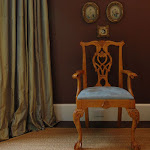If you don’t know by now I have a pretty healthy obsession with the color turquoise. It all started with a tiny French carriage clock given to me by my grandmother (who also LOVED the color) This tiny clock was a gift from her father after he returned from a long trip to France in the early 1900’s. He brought back three clocks for his three daughters, all somewhat similar- except for the color. My grandmother Alice had turquoise, her sisters Ines and Winn had pink and yellow. See my beloved clock below:

This clock started my obsession with turquoise, as well as a collection of Guilloche with enamel. According to Wikipedia:
Guilloché, phonetically pronounced gee-oh-SHAY is a French word for the process of engraving either by hand or by machine intricate repetitive patterns. Guilloché, is an engraving technique in which a very precise intricate repetitive pattern or design is mechanically etched into an underlying material with fine detail. Specifically, it involves a technique of engine turning, called guilloché in French after the French engineer “Guillot”, who invented a machine “that could scratch fine patterns and designs on metallic surfaces”. The machine improved upon the more time-consuming practice of making similar designs by hand, allowing for greater delicacy, precision, and closeness of the line, as well as greater speed. Yet another account is that it derives from the French word for an engraving tool, not the engine turning machine.Further details on Guilloche from e-Bay:
Although Enamel and Guilloché was used, pairing-first, applied by Peter Carl Fabergé on the Faberge eggs in the 1880’s-they are nevertheless two separate techniques and were not applied to one another until Fabergé.And then of course, there is my favorite- CLOCKS. See below a bevy of clocks to delight the eyes:
Below is a picture of Guilloche with out the applied enamel:

Next group of pictures below are examples of Guilloche after enamel:

The machines used to create guilloché designs are no longer produced. Today true guilloché can be found in mostly luxury watches and then only a very few companies practice the art. The guilloché technique can be seen in various antique and vintage jewelry and vanity items from compacts, pocket watches and dresser sets to charms.



Because this process is no longer practiced, these items have become very desirable, expensive and hard to find.














































































No comments:
Post a Comment